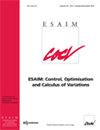Small-time local controllability of the bilinear Schrödinger equation with a nonlinear competition
IF 1.2
3区 数学
Q4 AUTOMATION & CONTROL SYSTEMS
Esaim-Control Optimisation and Calculus of Variations
Pub Date : 2023-10-31
DOI:10.1051/cocv/2023077
引用次数: 0
Abstract
We consider the local controllability near the ground state of a 1D Schrödinger equation with bilinear control. Specifically, we investigate whether nonlinear terms can restore local controllability when the linearized system is not controllable. In such settings, it is known that the quadratic terms induce drifts in the dynamics which prevent small-time local controllability when the controls are small in very regular spaces. In this paper, using oscillating controls, we prove that the cubic terms can entail the small-time local controllability of the system, despite the presence of such a quadratic drift. This result, which is new for PDEs, is reminiscent of Sussmann's $\S(\theta)$ sufficient condition of controllability for ODEs. Our proof however relies on a different general strategy involving a new concept of tangent vector, better suited to the infinite-dimensional setting.具有非线性竞争的双线性Schrödinger方程的小时局部可控性
考虑了一类双线性控制的一维Schrödinger方程在基态附近的局部可控性。具体来说,我们研究了当线性化系统不可控时,非线性项是否能恢复局部可控性。在这种情况下,众所周知,二次项在动力学中会引起漂移,当控制在非常规则的空间中很小时,这种漂移会阻止小时间局部可控性。在本文中,利用振荡控制,我们证明了三次项可以导致系统的小时局部可控性,尽管存在这样的二次漂移。这个结果对于偏微分方程来说是新的,它让人想起Sussmann关于偏微分方程可控性的$\S(\ θ)$充分条件。然而,我们的证明依赖于一种不同的一般策略,涉及一个新的切向量概念,更适合于无限维的设置。
本文章由计算机程序翻译,如有差异,请以英文原文为准。
求助全文
约1分钟内获得全文
求助全文
来源期刊

Esaim-Control Optimisation and Calculus of Variations
Mathematics-Computational Mathematics
自引率
7.10%
发文量
77
期刊介绍:
ESAIM: COCV strives to publish rapidly and efficiently papers and surveys in the areas of Control, Optimisation and Calculus of Variations.
Articles may be theoretical, computational, or both, and they will cover contemporary subjects with impact in forefront technology, biosciences, materials science, computer vision, continuum physics, decision sciences and other allied disciplines.
Targeted topics include:
in control: modeling, controllability, optimal control, stabilization, control design, hybrid control, robustness analysis, numerical and computational methods for control, stochastic or deterministic, continuous or discrete control systems, finite-dimensional or infinite-dimensional control systems, geometric control, quantum control, game theory;
in optimisation: mathematical programming, large scale systems, stochastic optimisation, combinatorial optimisation, shape optimisation, convex or nonsmooth optimisation, inverse problems, interior point methods, duality methods, numerical methods, convergence and complexity, global optimisation, optimisation and dynamical systems, optimal transport, machine learning, image or signal analysis;
in calculus of variations: variational methods for differential equations and Hamiltonian systems, variational inequalities; semicontinuity and convergence, existence and regularity of minimizers and critical points of functionals, relaxation; geometric problems and the use and development of geometric measure theory tools; problems involving randomness; viscosity solutions; numerical methods; homogenization, multiscale and singular perturbation problems.
 求助内容:
求助内容: 应助结果提醒方式:
应助结果提醒方式:


